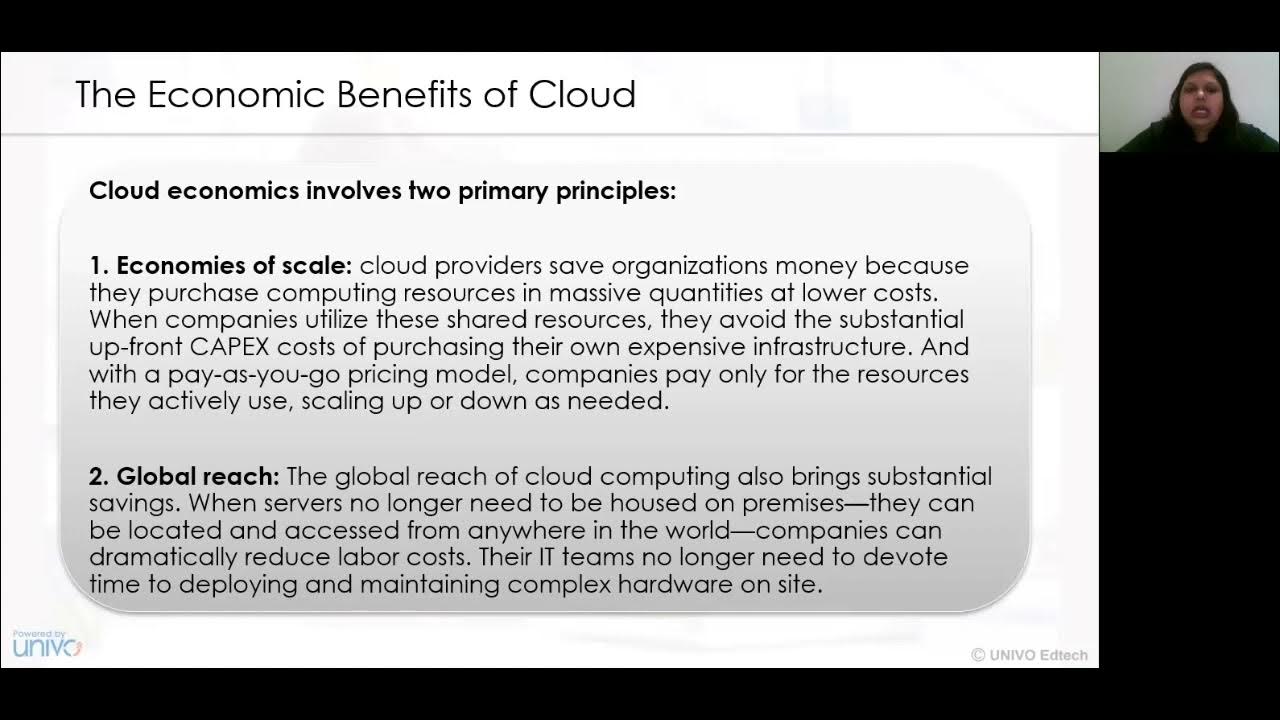AWS-Cloud Practitioner Course-004-Section1-Cloud Computing Benefits
Summary
TLDRThe video script highlights six key benefits of cloud computing: 1) Reduced upfront investment with a pay-as-you-go model, enhancing cash flow; 2) Cost savings by eliminating expenses on data center maintenance; 3) Elimination of capacity guessing with elastic, scalable cloud resources; 4) Economies of scale leading to lower variable costs; 5) Global reach with low latency for end-users; 6) Increased speed and agility in deploying applications compared to on-premises environments.
Takeaways
- 💼 **Pay-as-you-go Model**: Cloud computing allows businesses to shift from upfront investments to a variable expense model based on usage.
- 💸 **Cost Savings**: By reducing the need to manage physical infrastructure, cloud computing can lead to significant cost savings.
- 🚀 **Elasticity**: Cloud resources can dynamically scale up or down according to demand, eliminating the need for capacity forecasting.
- 🌐 **Economies of Scale**: Cloud providers like AWS leverage economies of scale to offer lower variable costs compared to self-hosting.
- 🌍 **Global Reach**: Cloud computing enables rapid deployment of applications worldwide, ensuring low latency for end-users.
- 🔧 **Reduced Infrastructure Management**: With cloud computing, businesses can focus less on infrastructure management and more on developing applications and serving users.
- 📈 **No Guesswork**: Unlike on-premises deployments, cloud computing eliminates the guesswork involved in capacity planning.
- 🏎️ **Speed and Agility**: Cloud resources can be provisioned quickly, leading to faster time to market and increased agility.
- 🌟 **AWS Global Infrastructure**: AWS's global infrastructure allows for quick deployment and low latency, which will be discussed in more detail in upcoming course videos.
- ⏱️ **Time Efficiency**: On-premises hardware procurement and setup can take weeks or months, whereas cloud resources can be set up within minutes.
Q & A
What is the first benefit of cloud computing mentioned in the transcript?
-The first benefit is the ability to switch from upfront investments to a variable-based expense model based on consumption, also known as the pay-as-you-go model.
How does cloud computing enhance cash flow?
-Cloud computing enhances cash flow by eliminating the need to pay in advance for technology, allowing businesses to only pay for what they use.
What is the second benefit of cloud computing discussed in the transcript?
-The second benefit is cost savings, as it allows businesses to focus less on managing infrastructure and servers and more on applications and end users.
Why is there no more guesswork with cloud computing?
-With cloud computing, there is no need to predict capacity in advance like with on-premises deployments. Cloud resources are elastic, allowing businesses to dynamically adjust resources based on demand.
What is the concept of economies of scale in the context of cloud computing?
-Economies of scale in cloud computing refer to the cost benefits achieved by providers like AWS due to their large customer base, which allows them to offer lower variable costs to their users.
How does cloud computing allow for a global footprint?
-Cloud computing enables the deployment of applications worldwide quickly, providing a global footprint and low latency for end users.
What is the final benefit of cloud computing mentioned in the transcript?
-The final benefit is the improvement in speed and agility, as cloud resources can be set up and accessed within minutes, leading to faster time to market.
How does cloud computing compare to on-premises environments in terms of hardware procurement and setup?
-Cloud computing is much faster than on-premises environments, where procuring and setting up hardware can take weeks or months.
What does the pay-as-you-go model mean for businesses?
-The pay-as-you-go model means businesses only pay for the cloud services they use, which can lead to optimized costs and improved cash flow management.
How does cloud computing help in managing infrastructure and servers?
-Cloud computing reduces the need for businesses to manage their own infrastructure and servers, as these tasks are handled by the cloud provider.
What is the significance of cloud resources being elastic?
-Elasticity of cloud resources allows businesses to scale up or down quickly in response to changing demand, which is more efficient and cost-effective than predicting and provisioning for capacity in advance.
Outlines

This section is available to paid users only. Please upgrade to access this part.
Upgrade NowMindmap

This section is available to paid users only. Please upgrade to access this part.
Upgrade NowKeywords

This section is available to paid users only. Please upgrade to access this part.
Upgrade NowHighlights

This section is available to paid users only. Please upgrade to access this part.
Upgrade NowTranscripts

This section is available to paid users only. Please upgrade to access this part.
Upgrade NowBrowse More Related Video

6 Advantages of Cloud Computing

What is Cloud Computing with Amazon Web Services

The 5 Benefits of Cloud Computing Explained in 3 Minutes

AZ-900 Episode 3 | CapEx vs OpEx and their differences | Microsoft Azure Fundamentals Full Course

Cloud Economics Cloud Computing infrastructures available for implementing cloud based services

The Six Main Benefits of Cloud Computing with Amazon Web Services
5.0 / 5 (0 votes)